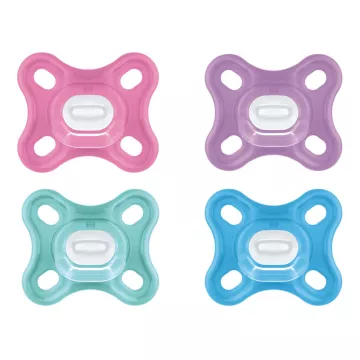
A silicone soother is a type of pacifier made primarily from silicone, a synthetic material renowned for its durability and safety. Unlike traditional soothers, silicone soothers offer a soft texture that mimics the mother's breast, which can help soothe and comfort babies. They are often recommended for newborns and young children, as they do not absorb odors or flavors, and are easy to sterilize, guaranteeing optimal hygiene.
Silicone soothers differ from other materials such as latex or rubber for several reasons. Firstly, silicone is hypoallergenic, making it ideal for allergy-sensitive children. What's more, this material is more resistant to heat and tearing, extending the life of the pacifier. In terms of safety and comfort, silicone remains soft and supple even after multiple uses and cleaning, making it very practical for everyday use.
The choice of silicone soother should be made with care, taking into account your child's age and specific needs. Soothers are generally classified by age group, making it easier to select the right size. It's important to choose a shape that mimics the mother's breast, especially if your baby is breast-feeding, to avoid any suckling confusion. Orthodontic shapes are also recommended, as they promote healthy oral development.
To keep your silicone soother clean and hygienic, it's essential to wash it regularly. You can clean it in hot, soapy water, or place it in the dishwasher if it's designed for that purpose. For sterilization, most silicone soothers can be boiled without risk of deformation or degradation, or used with steam sterilizers specially designed for childcare products. It is advisable to replace the pacifier every two to three months to ensure your child's safety.
Although silicone soothers are safe, prolonged use can lead to dental problems such as malocclusion. We recommend that you start weaning your child off pacifiers at around two to three years of age to avoid such risks. In addition, be sure to inspect the pacifier regularly for any signs of wear or damage that could present a choking hazard.
It's crucial to check that the silicone soother you choose is free from BPA (bisphenol A) and phthalates, two potentially harmful chemicals. To do this, look for certifications on the product's packaging indicating that it meets European (EN) or American (FDA) safety standards. These certifications guarantee that the pacifier has been tested and complies with strict regulations concerning the materials used in products intended for children.
Yes, it is possible to attach a silicone soother to a soother clip, which is practical for preventing the soother from falling to the ground or getting lost. However, be sure to choose a clip designed to be safe and without risk of strangulation. The clip should be of regulation length and made from safe materials, without sharp edges or small detachable parts.
Silicone soothers are often used to soothe babies during teething because of their soft, supple texture, which is pleasant for sensitive gums. Some silicone soothers are even specially designed with extra textures to gently massage the gums, which can provide additional relief during teething.
To avoid over-dependence on silicone soothers, we recommend using them in moderation. Limit pacifier use to times of sleep and need for comfort. It's also important to encourage your child to develop other forms of comfort, such as a comforter or cuddles, so as not to make the pacifier the sole source of consolation.
Silicone soothers for premature babies are specially designed to be smaller and lighter, adapted to the size and sucking force of premature babies. These soothers help stimulate the sucking reflex that is crucial to their oral and feeding development. In comparison, pacifiers for full-term babies are generally larger and adapted to the rapid growth of the child's mouth and teeth.